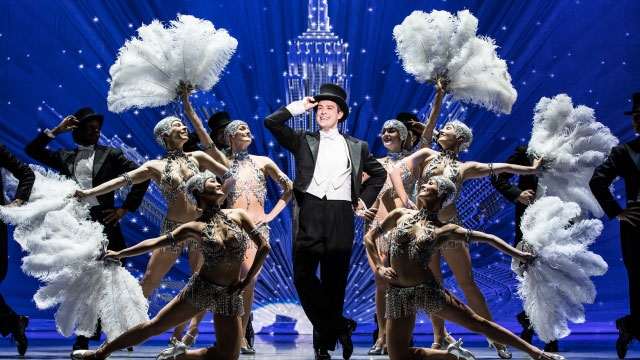Christopher Wheeldon, the British-born Royal Ballet trained dancer and one of the world’s most innovative and celebrated choreographers, created a ballet based on An American in Paris, the iconic multiple Oscar-winning 1951 Vincente Minelli film starring Gene Kelly and Leslie Caron, in 2005 for New York City Ballet, but he had never before directed actors.
The musical “An American in Paris,” which won several Tonys among other coveted awards when it took Broadway by storm in 2015, more than proves his chops in that regard; it seems quite clear this is a show he was born to create.
Now on tour at the Wharton Center in Lansing, “An American in Paris” is simply exquisite. The perfect blend of classical ballet elegance and musical theater panache, with stunningly innovative, cinematic design and a score of Gershwin standards offering the best of 20th Century American music, it is achingly romantic without sentimentality largely because of its extraordinary beauty and depth of theme: that regardless of obstacle, one’s life is to be a work of art.
Set at the end of World War II, Paris emerges as a character through the eyes of aspiring artist and American GI Jerry Mulligan. More accurately, Paris springs to life through Bob Crowley’s inspired set and lighting design in which iconic images of the city of light appear like black and white sketches but give way to warm and glorious impressionistic paintings. Clouds subtly float above the city skyline and stars flicker in the reflection of the Seine while interiors of a French cafe, ballet studio, and the Galeries Lafayette shift in perspective and point of view in reverence to moving pictures.
Yet the bold characters sing and dance magnificently front and center against these breathtaking and varied backdrops. McGee Maddox is the consummate boyish and exuberant Yankee Jerry, a perfect contrast to Allison Walsh’s uber French Lise, a ballerina on the brink of her big break. Brash American art dealer Milo Davenport (a wonderful Kirsten Scott) has her eyes set on Jerry; wealthy Henri Baurel (Ben Michael) believes he has successfully proposed to Lise; and forlorn, wounded, smart and funny composer Adam Hochberg is falling in love with Lise, or at the very minimum, with her light and the artistry she inspires in his music. They're all aspiring and their paths inextricably linked—culminating in a big, gorgeous, experimental, post-war, avant-garde ballet in which love—between lovers and between artists and their art form—is expressed so purely it practically knocks you out, 20 rows back.
And leading up to that point is a sequence of extraordinary numbers that range from a fabulous and sparkly Busby Berkeley showgirl dream sequence to a tremendous toe-tapping, jazzy and comedic ensemble number with chairs. Every ensemble member and lead is quite clearly a classically-trained dancer who can also sing and act beautifully. The three central males complement each other physically, vocally, and energetically—and Allison Walsh, who played Lise in the original Broadway production, is both demure and powerful in her quiet strength, unapologetically sensual and French, while Kirsten Scott’s Milo is equally bold as a pushy and direct, overtly sexual American.
The cast is astoundingly talented — and impressively indistinct from the glorious design of the show, which, ultimately reinforces the theme of art and life as inseparable. Ensemble members dance and twirl set pieces on and off stage for every scene change; actors appear within picture frames suspended in air — framing their bodies, their lives, as works of art.
The only discernible weakness here is how sanitized some of songs come off; it’s impossible to hear “The Man I Love” with any feeling in a straight musical after having been raised on Billie Holliday’s searing rendition. However, Matthew Scott and Kirsten Scott offer a gorgeously painful duet of “But Not for Me” and “I Got Rhythm,” “’S Wonderful,” and “They Can’t Take That Away From Me” remain infinitely resonant and memorable, especially as performed here with an exceptional orchestra and gorgeous harmonies. They’re still some of the best songs ever written for the theatre.
Ultimately, “An American in Paris” offers a transcendent escape — through the horrors and beauty of another time and place, art and love are inextricable and offer very real salvation. Like the film, this iteration of the classic tale is near perfection in its own right.
An American In Paris
Wharton Center
Nov. 14-19
whartoncenter.com





